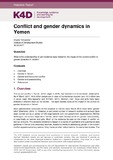| dc.contributor.author | Rohwerder, Brigitte | |
| dc.coverage.spatial | Yemen | en |
| dc.date.accessioned | 2017-07-24T13:05:37Z | |
| dc.date.available | 2017-07-24T13:05:37Z | |
| dc.date.issued | 2017-03-30 | |
| dc.identifier.citation | Rohwerder, B. (2017). Conflict and gender dynamics in Yemen. K4D Helpdesk Report. Brighton, UK: Institute of Development Studies. | en |
| dc.identifier.uri | https://opendocs.ids.ac.uk/opendocs/handle/20.500.12413/13120 | |
| dc.description.abstract | The current conflict in Yemen, which began in 2015, has resulted in a humanitarian catastrophe. As of March 2017, 18.8 million people are in need of humanitarian support, and 10.3 million are in acute need (Sikurajapathy and Al-Fotih, 2017). Women, men, boys and girls have been affected in different ways by the conflict. This rapid reviews looks at the impact of the conflict on gender dynamics in Yemen. Most assessments conducted on the situation in Yemen since March 2015 have been ‘gender blind’ (Basharen, 2016: 1). However, a very small number of research studies and surveys have been carried out by a variety of UN organisations and non-government organisations (NGOs) working on the current response in Yemen, which have focused either on gender more broadly, or specifically on women and girls. Much of the evidence focuses on the impact of conflict on women and girls. The available evidence is based on a variety of qualitative and quantitative data
gathered in Yemen and secondary sources. Academic literature addressing gender in the current conflict appears extremely scarce. Grey literature often refers back to the same few studies. The reports produced by organisations working in Yemen, such as OXFAM, Saferworld, and CARE, provide recommendations and on-the-ground perspectives of the priorities, needs and aspirations of conflict-affected communities. Yemen ranks last out of the 144 countries included in the 2016 World conomic Forum’s Global Gender Gap Index, a position it has held for the last 10 years. Even prior to the conflict, Yemeni women and girls experienced systematic discrimination and marginalisation. However, some progress was being made and the 2011 uprising challenged the norm of women’s limited participation in society with women actively participating in the protests, while women represented more than one-quarter of participants in the National Dialogue Conference (NDC) in 2014. Conflict threatens to reverse the advances made in recent years to address gender equality in Yemen. | en |
| dc.description.sponsorship | DFID | en |
| dc.language.iso | en | en |
| dc.publisher | Institute of Development Studies | en |
| dc.relation.ispartofseries | K4D Helpdesk Report;064 | |
| dc.rights.uri | https://www.nationalarchives.gov.uk/doc/open-government-licence/version/3/ | en |
| dc.subject | Conflict | en |
| dc.subject | Gender | en |
| dc.subject | Social Development | en |
| dc.title | Conflict and Gender Dynamics in Yemen | en |
| dc.type | Helpdesk | en |
| dc.rights.holder | DFID | en |
| dcterms.dateAccepted | 2017-03-30 | |
| rioxxterms.funder | Default funder | en |
| rioxxterms.identifier.project | K4D | en |
| rioxxterms.version | AO | en |
| rioxxterms.funder.project | 9ce4e4dc-26e9-4d78-96e9-15e4dcac0642 | en |

